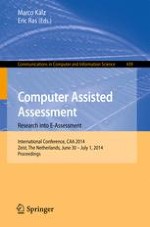2014 | Book
Computer Assisted Assessment. Research into E-Assessment
International Conference, CAA 2014, Zeist, The Netherlands, June 30 – July 1, 2014. Proceedings
Editors: Marco Kalz, Eric Ras
Publisher: Springer International Publishing
Book Series : Communications in Computer and Information Science
